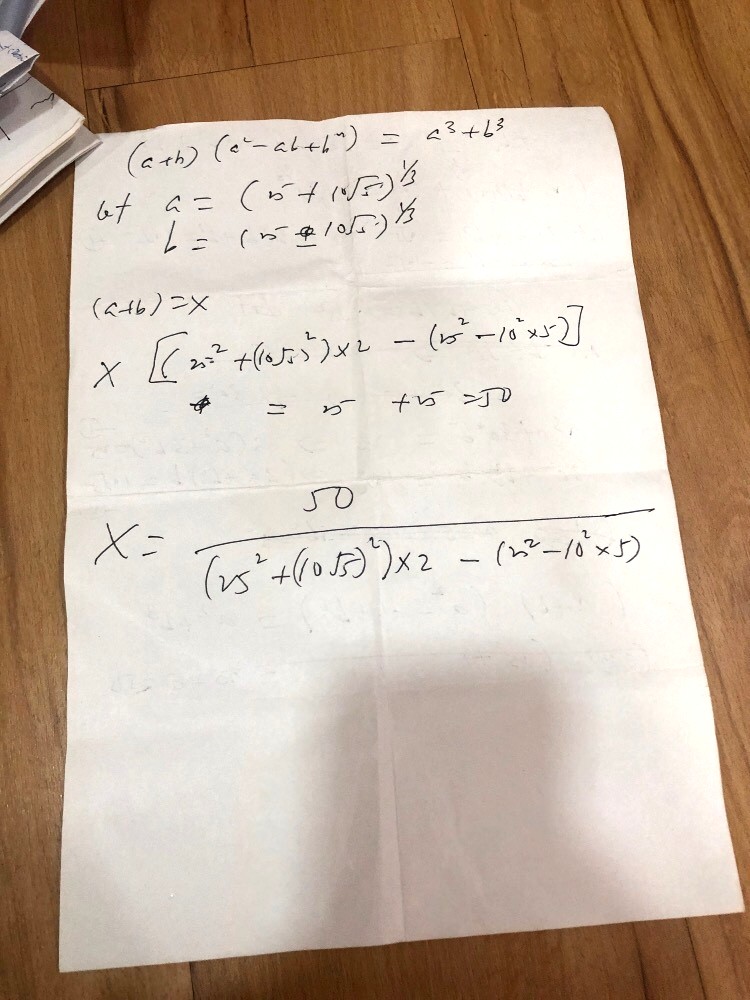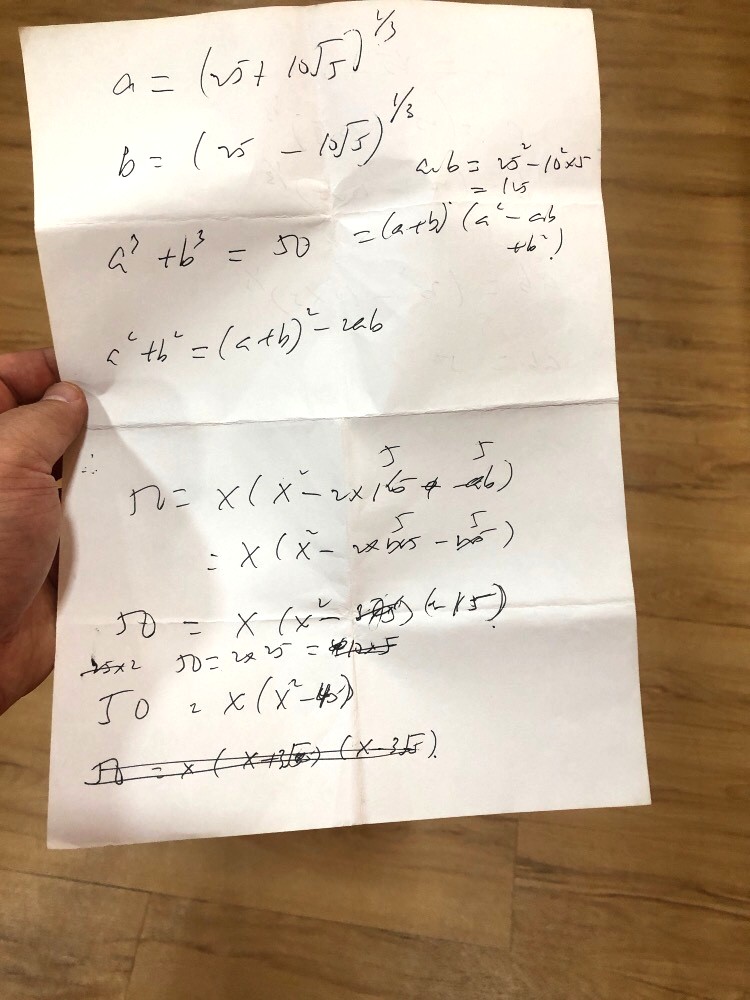Ask Singapore Homework?
Upload a photo of a Singapore homework and someone will email you the solution for free.

Question
secondary 2 | Maths
3 Answers Below
Anyone can contribute an answer, even non-tutors.

surds
x³ = [ (25 + 10√5)^⅓ + (25 - 10√5)^⅓ ]³
x³ = ((25 + 10√5)^⅓)³
+ 3((25 + 10√5)^⅓)² (25 - 10√5)^⅓
+ 3(25 + 10√5)^⅓ ((25 - 10√5)^⅓)²
+ ((25 - 10√5)^⅓)³
(Property used is (a+b)³ = a³ + 3a²b + 3ab² + b³)
= 25 + 10√5
+ 3(25 + 10√5)^⅓ (25 - 10√5)^⅓ ( (25 + 10√5)^⅓ + (25 - 10√5)^⅓ )
+ 25 - 10√5
= 50 + 3[(25+10√5)(25-10√5)]^⅓ x
= 50 + 3[25² - (10√5)²]^⅓ x
= 50 + 3(625 - 500)^⅓ x
= 50 + 3(125)^⅓ x
= 50 + 3(5)x
= 50 + 15x
So, x³ = 50 + 15x
x³ - 15x - 50 = 0
When x = 5, x³ - 15x - 50
= 5³ - 15(5) - 50
= 125 - 75 - 50
= 0
By the Factor Theorem, (x - 5) is a factor.
Factorise (either mentally or long division)
(x - 5)(x² + 5x + 10) = 0
(x - 5) = 0
x = 5
or
x² + 5x + 10 = 0
For x² + 5x + 10,
discriminant = 5² - 4(1)(10)
= 25 - 40
= -15 < 0
Since discriminant < 0, there are no real roots/solutions for this equation.
∴ (25 + 10√5)^⅓ + (25 - 10√5)^⅓ = 5
(25 + 10√5)^⅓ + (25 - 10√5)^⅓
= [⅛(200 + 80√5)]^⅓ + [⅛(200 - 80√5)]^⅓
= [⅛(125 + 75√5 + 75 + 5√5)]^⅓ + [⅛(125 - 75√5 + 75 - 5√5)]^⅓
= [⅛(5³ + 3x5x5x√5 + 3x5x5 + √5 x √5 x √5)]^⅓ + [⅛(5³ - 3x5x5x√5 + 3x5x5 - √5 x √5 x √5)]^⅓
= [⅛(5³ + 3(5²)√5 + 3(5)(√5)² + (√5)³)]^⅓ + [⅛(5³ - 3(5²)√5 + 3(5)(√5)² - (√5)³)]^⅓
= [⅛(5 + √5)³)]^⅓ + [⅛(5 - √5)³]^⅓
(Property used is (a+b)³ = a³ + 3a²b + 3ab² + b³)
= (⅛)^⅓ ((5 + √5)³)^⅓ + (⅛)^⅓ ((5 - √5)³)^⅓
= ½(5+√5) + ½(5 - √5)
= ½(5 + √5 + 5 - √5)
= ½(10)
= 5
See 3 Answers

The formula
Know that
The square in between can be cancelled
Redo the sum
It is not that difficult
i.e
-ab = - (25 + 10√5)^⅓ (25 - 10√5)^⅓
= - (25² - 10² x 5)^⅓
= - (125)^⅓
= -5
But a² and b² still have the exponentials.
i.e a² = (25 + 10√5)^⅔
b² = (25 - 10√5)^⅔
a² + b² will not simplify to (25² + (10√5)²) x 2,
A + B Perfect square is a square plus b square mijus two ab
The point is, you should be getting
50 = x((a+b)² - 2ab - ab)
50 = x(x² - 2(125)^⅓ - (125)^⅓)
50 = x (x² - 2(5) - 5)
50 = x(x² - 15)
50 = x³ - 15x
x³ - 15x - 50 = 0
Which is not what you wrote above
.

But this method is correct. You should end up with x³ - 15x - 50 = 0 however.
I used (a + b)³ = a³ + 3a²b + 3ab² + b³
The intent of the teacher is to know the property of surfs
I didn’t skip steps
This is how should be done
The thinking processes matter
I suggest if you want to help put in answer not just comments so that we won’t help
The idea is to realise that the middle terms
can be changed into 3(ab)(a+b), which can be easily simplified.
You realised that a³ + b³ = (a + b)(a² - ab + b²) is derived from this, don't you?
Your method in fact, incurred an extra step by having to use a² + b² = (a+b)² - 2ab , which is extra work.
So you used 2 identities :
a³ + b³ = (a + b)(a² - ab + b)²
a² + b² = (a + b)² - 2ab
Compared to my single identity :
(a + b)³ = a³ + 3a²b + 3ab² + b³
= a³ + b³ + 3ab(a+b)
Yet, you say that my method is lengthy and naggy when yours is more complicated but basically uses the same principle of conjugates to reach the same conclusion of x³ - 15x - 50 = 0
My point is, if you want to help, make sure your workings are correct and they lead logically to the next step.
It is far easier to write in comments than to post an answer which would appear as a wall of text.
Handwriting issues are very common here, as we can see from yours (pretty illegible I must say)
This is Just guide
I am not spoon feeding them because during exam no one can help them
(i.e (a + b)^⅓(a - b)⅓ = ((a+b)(a-b))^⅓
= (a² - b²)^⅓
You are free to help or post an alternative answer as a tutor. Perhaps the student likes yours better. If you're so worried about having duplicate answers, then you are free to check the main comments section first.
This is Olympiad Math so knowledge of (a+ b)³ is to be expected, along with a³ + b³ = (a + b) (a² -ab + b²) The latter is only taught in sec 3 for A Math)
a² + b² = (a + b)² - 2ab is also expected as it's already covered in sec 2.
If you want to write so much I rather you do more math if you are really helpful
I also try to point out working mistakes that people have, so the students do not risk writing the wrong thing or being misinformed.
Your first picture contained working errors so I was being nice by pointing it out to you.
But now you want to come and call my method too lengthy and naggy, when all I did was to show full working, and it was equally valid.
Whereas yours is brief writings (hardly legible and with mistakes). In fact, this photo here, your second attempt, contained mistakes again (how is the last step 50 = x(x² - 45) ???).
So you have no right to say anything about lengthy and when you have provided inaccurate and incomplete answers in the first place.
You should learn to accept your errors instead of being so defensive. And also, double check your working and proofread before posting.
Saves you embarrassment and keeps your credibility up.
No one said your method is wrong. I agree with it.
You should also realise that for mathematics, there are multiple approaches to each problem. No one method is superior or inferior to others.
What more, when our answers use the same principle of binomial expansion.
The whole point is to be exposed to different techniques and methods (especially for Olympiad Math)
The goal should be to provide working as clear and logical/intuitive as possible.
Guidelines/brief methods only confuse many of them, which would eventually prompt more questions
So, full workings aren't spoon-feeding in this context.
Take x is 5
Then the Rhs is equal to lhs





